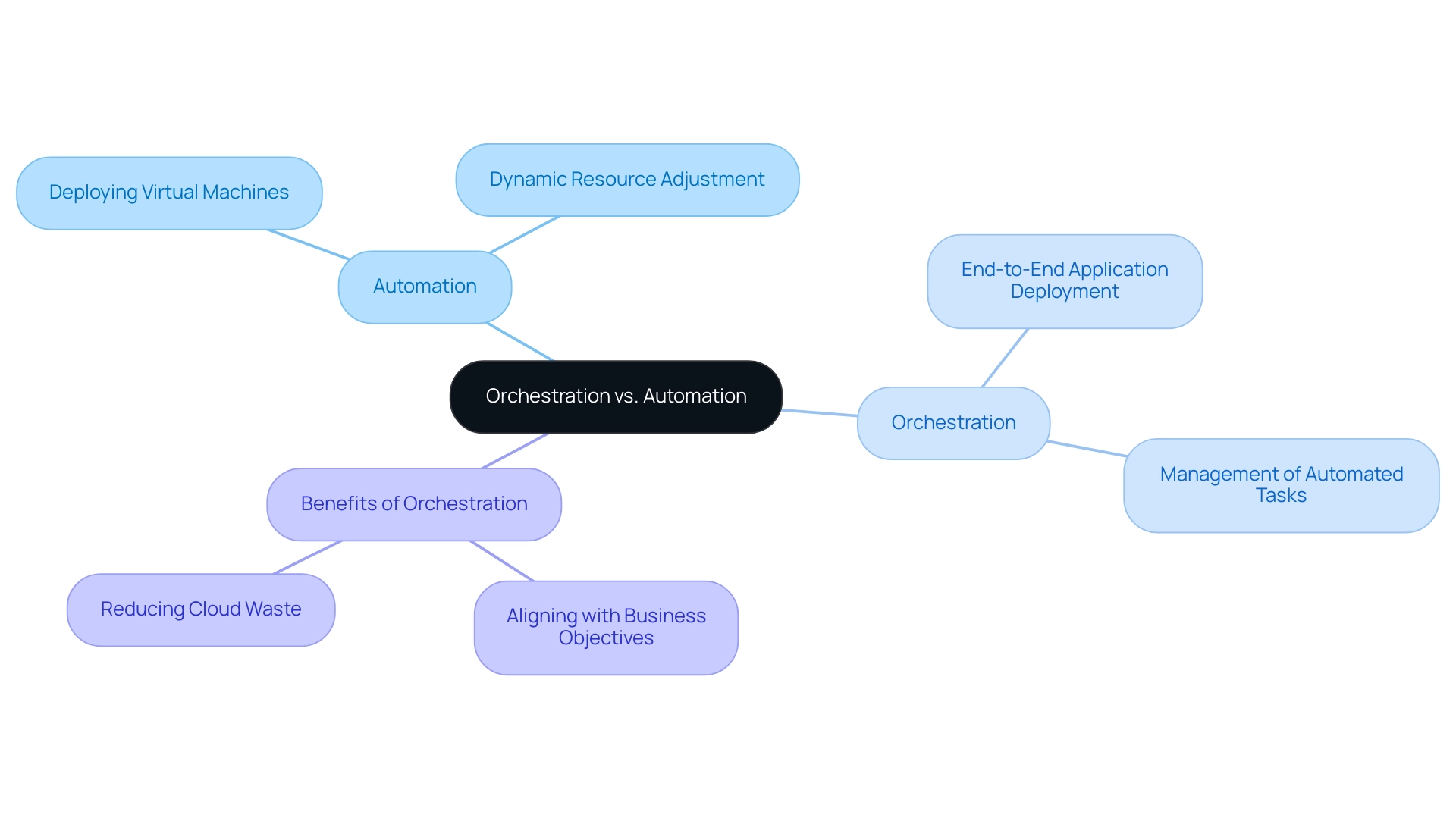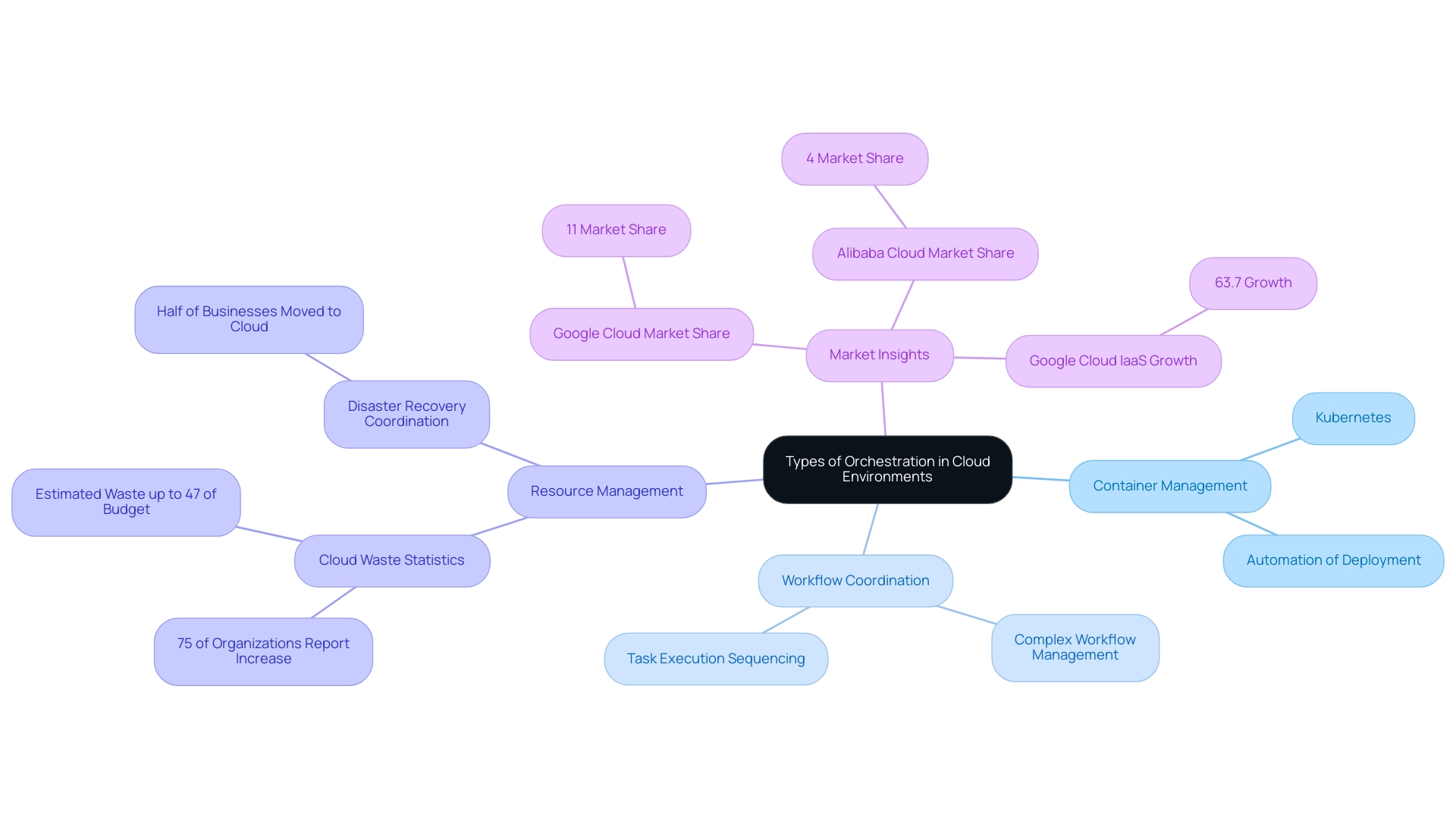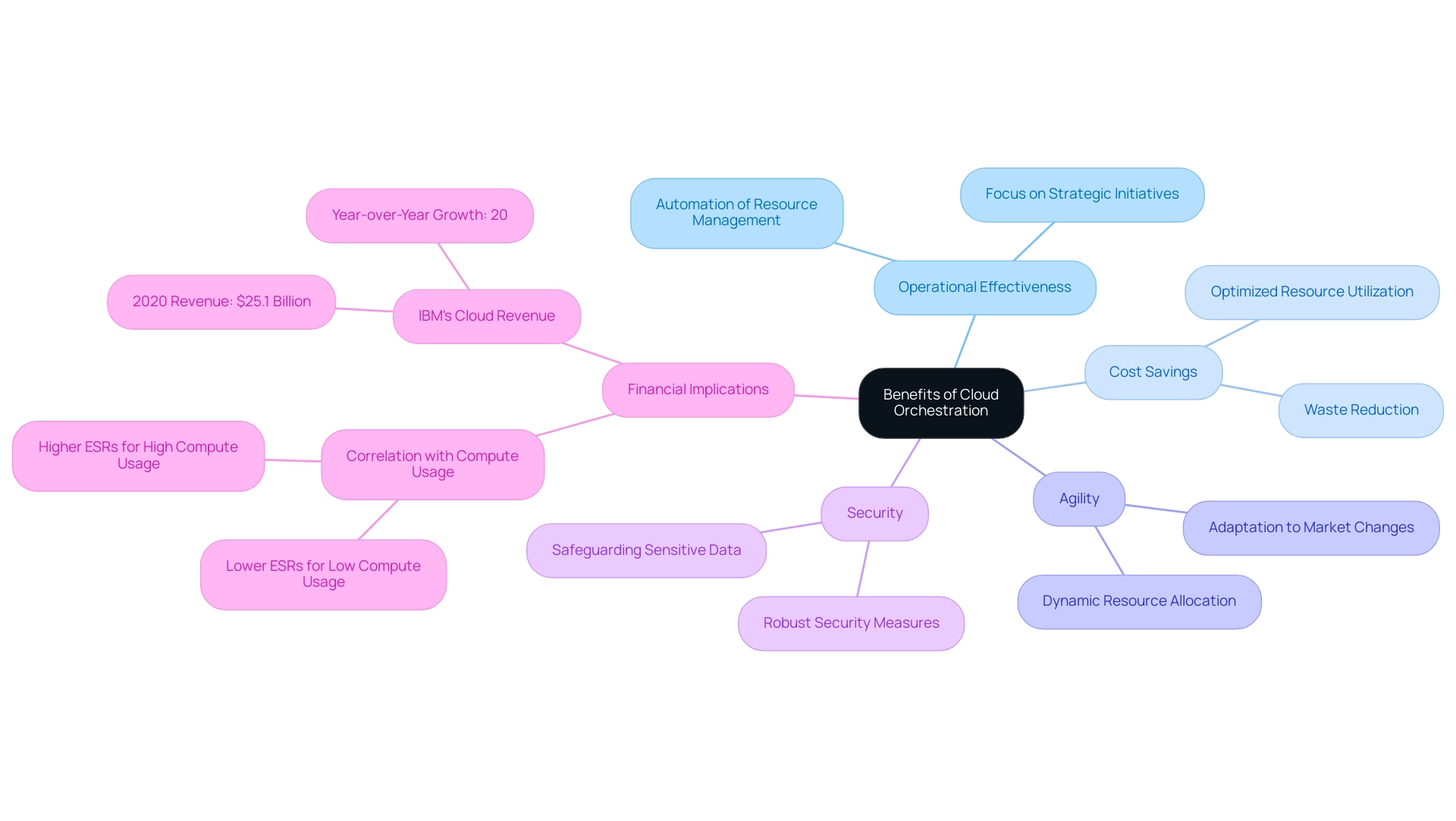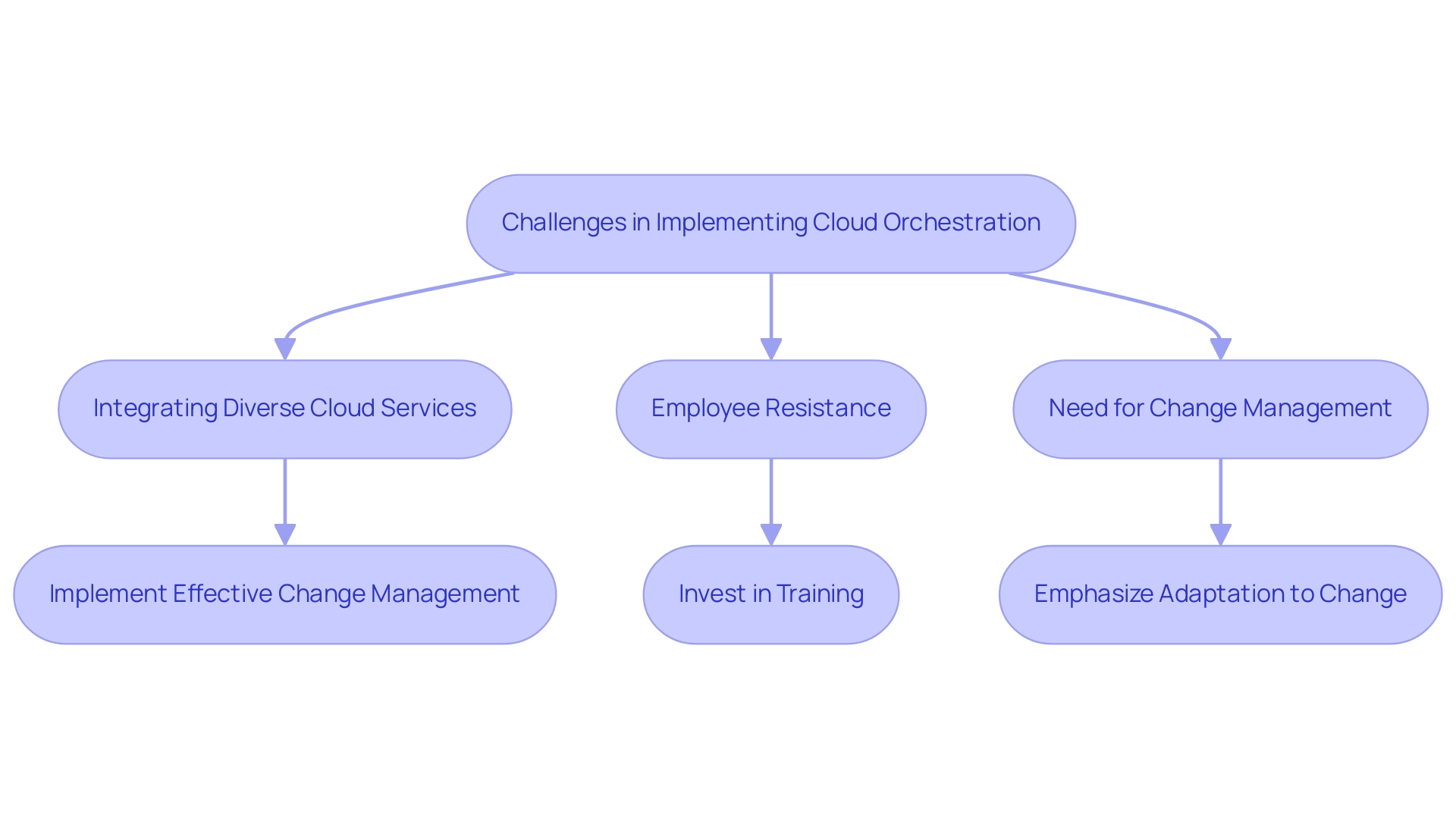Introduction
In the contemporary landscape of cloud computing, orchestration emerges as a fundamental pillar for organizations striving to maximize operational efficiency and agility. Defined as the automated coordination and management of complex systems and services, orchestration plays a critical role in ensuring that diverse cloud applications work harmoniously together.
As businesses increasingly rely on cloud solutions to drive innovation and competitive advantage, the importance of effective orchestration strategies cannot be overstated. With the potential for significant cost savings and enhanced resource utilization, organizations must navigate the complexities of integrating various cloud services while addressing the challenges associated with implementation.
This article delves into the multifaceted world of cloud orchestration, exploring its:
- Definitions
- Key differences from automation
- Types
- Benefits
- Hurdles organizations face in adopting these essential frameworks
Defining Orchestration in Cloud Computing
Orchestration in cloud computing is characterized as the automated organization, coordination, and management of complex computer systems and middleware. This process entails the smooth incorporation of various online solutions and workflows, ensuring that they function together to attain maximum efficiency. By automating workflows and enabling communication among different systems, coordination significantly improves operational efficiency for companies.
In the rapidly changing setting of online environments, where many services and applications must interact smoothly, the function of coordination becomes increasingly vital. As noted by Mariusz Michalowski, as internet-based computing evolves into a business necessity, it will become a key innovation facilitator for organizations that embrace it. This highlights the necessity for CTOs to embrace coordination strategies to utilize the full capacity of computing resources, especially in promoting agile transformation.
Furthermore, the financial consequences of overlooking coordination are significant, with the average expense of a data breach in online environments hitting $3.86 million, highlighting the necessity for strong coordination frameworks. Practical implementations, like the collaboration between Microsoft and AT&T, further demonstrate this idea, as they utilize coordination to improve computing services across IoT, AI, and AR. Moreover, IBM's reported revenue from its online services of $25.1 billion in 2020, indicating a year-over-year growth rate of 20%, underscores the market's rising dependence on coordination to achieve business success.

Orchestration vs. Automation: Key Differences
Orchestration in cloud computing and automation are both integral to enhancing operational efficiency in cloud environments, yet they fulfill distinct roles. Automation entails the execution of specific, discrete tasks without the need for human oversight. For instance, deploying a virtual machine or dynamically adjusting resource capacity according to demand exemplifies automation in action.
In contrast, coordination manages the interplay of various automated tasks and services to facilitate a more intricate, overarching process. An illustrative example of coordination would be managing the end-to-end deployment of an application, which includes automating the provisioning of servers, configuring networks, and establishing storage solutions—each of which comprises automated tasks that must function together seamlessly.
As highlighted in a recent Camunda report, 48% of companies are currently implementing automated systems, reflecting a significant shift toward operational efficiency.
However, it is crucial to recognize the nuances; orchestration in cloud computing not only enhances automation but also adds an essential layer of management that aligns automated processes with broader business objectives. This differentiation is crucial, particularly as usage of online services increases—Google’s IaaS offering, for instance, reported an impressive growth of 63.7%. Furthermore, as companies increase their cloud spending, they often encounter rising cloud waste, with StormForge's findings indicating that some entities waste as much as 47% of their cloud budget.
By adopting effective orchestration in cloud computing strategies, organizations can mitigate this waste by ensuring that automated tasks are not only executed efficiently but are also strategically aligned to optimize resource use.
Nick Rockwell, Content Marketing Manager, emphasizes this point by stating, 'The implementation of automated systems is not just about efficiency; it's about ensuring that these systems work together to meet business goals.' Furthermore, the financial performance of CloudVelox Inc. demonstrates the significance of aligning automation and coordination strategies, as companies that integrate these approaches effectively can enhance their operational outcomes and reduce unnecessary expenditures.

Types of Orchestration in Cloud Environments
In the varied terrain of virtual environments, different management types fulfill unique and vital roles. Orchestration in cloud computing is crucial for overseeing the deployment and operation of applications across various online services, ensuring smooth interaction and functionality among these applications. As Veeam mentions, 'The online environment plays an essential part in today’s data protection strategy,' highlighting the importance of coordination in disaster recovery, particularly as half of the surveyed companies have transitioned to this system for this aim.
Container management, prominently illustrated by Kubernetes, automates the deployment, scaling, and administration of containerized applications, streamlining workflows and enhancing operational efficiency. Notably, 75% of organizations report an increase in cloud waste, with estimates suggesting that waste could be as high as 47% of their cloud budget. This emphasizes the importance of orchestration in cloud computing for effectively managing resources.
Conversely, orchestration in cloud computing is crucial for coordinating complex workflows that involve multiple services and systems, ensuring that each task is executed in the appropriate sequence and at the right time. A case study on Google Cloud's IaaS growth, which witnessed a 63.7% rise, illustrates the strong demand for management solutions. By comprehending these coordination types, entities can make informed choices when choosing the most appropriate coordination solutions to satisfy their specific operational requirements.

Benefits of Cloud Orchestration: Enhancing Efficiency and Cost Savings
The execution of orchestration in cloud computing serves as a crucial approach for organizations aiming to improve their operational effectiveness. By implementing orchestration in cloud computing to automate the management of online resources and services, companies can redirect their focus from routine operational tasks to strategic initiatives that drive growth. This approach not only streamlines processes but also fosters significant cost savings, akin to orchestration in cloud computing, through optimized resource utilization and waste reduction.
For instance, orchestration in cloud computing allows management tools to enable dynamic resource allocation based on real-time demand, effectively minimizing both over-provisioning and underutilization. As a result, businesses can achieve greater agility through orchestration in cloud computing, which allows them to swiftly adapt to evolving market conditions and customer expectations. Notably, in 2020, IBM reported a remarkable revenue from its online services of $25.1 billion, reflecting a year-over-year growth rate of 20%.
As IBM indicated, 'The future of enterprise lies in online solutions,' emphasizing the rising dependence on such technologies and the need for efficient orchestration in cloud computing to manage the escalating intricacy of digital environments. Furthermore, with over 60% of corporate data now stored online, the need for robust security measures becomes paramount. This trend raises security concerns among analysts, reinforcing the importance of orchestration in cloud computing to safeguard sensitive data while enhancing operational capabilities.
Furthermore, companies with minimal compute usage, investing under $1M annually, exhibit lower Enterprise Spending Rates (ESRs) in comparison to those investing over $5M per year, suggesting a distinct financial impact of efficient management.

Challenges in Implementing Cloud Orchestration Solutions
Despite the numerous benefits that online management provides, organizations face considerable obstacles during implementation. One primary obstacle is the intricate task of integrating diverse cloud services to facilitate orchestration in cloud computing and ensure seamless communication among them. Furthermore, there is often considerable resistance to change from employees who are accustomed to established workflows, which can hinder the adoption of new processes.
Effective change management strategies are vital to navigating these cultural shifts and promoting acceptance of orchestration in cloud computing tools. Tajammul Pangarkar, CMO at Prudour Pvt Ltd, emphasizes that tackling these challenges is crucial, stating, "The tech world is constantly evolving, and companies must adapt to stay relevant." Additionally, investing in comprehensive training and skill development is crucial for equipping teams with the expertise required to manage these tools adeptly.
A recent study emphasizes that 98% of U.S. companies have embraced online services for various business activities, reflecting a significant change in operational strategies. This widespread adoption underscores the urgency of addressing implementation challenges, especially as the Platform-as-a-Service (PaaS) market is projected to reach USD 216 billion by 2022, with a compound annual growth rate (CAGR) of 24.7% from 2019 to 2023. Proactively tackling these challenges has become essential for organizations aiming to leverage orchestration in cloud computing successfully.

Conclusion
The exploration of cloud orchestration reveals its critical role in enhancing operational efficiency and aligning automated processes with overarching business objectives. As outlined, orchestration involves the automated management and coordination of diverse cloud services, ensuring that they function together seamlessly. This not only drives agility and innovation but also mitigates financial risks associated with cloud mismanagement, as evidenced by the staggering costs linked to data breaches.
Understanding the distinction between orchestration and automation is essential for organizations navigating the complexities of cloud environments. While automation focuses on individual tasks, orchestration integrates these tasks into cohesive workflows that align with strategic goals. The various types of orchestration, including:
- Application orchestration
- Container orchestration
- Workflow orchestration
each serve unique functions that are vital for resource management and operational success.
Despite the myriad benefits, the path to effective cloud orchestration is not without challenges. Organizations must confront obstacles such as integrating diverse cloud services and overcoming resistance to change. Addressing these challenges through comprehensive training and change management strategies is crucial for harnessing the full potential of orchestration frameworks.
In summary, as businesses increasingly rely on cloud solutions, the need for robust orchestration strategies becomes paramount. Embracing these strategies not only enhances efficiency and reduces costs but also positions organizations to thrive in an ever-evolving digital landscape. The imperative is clear: investing in cloud orchestration is not merely a technological upgrade; it is a strategic necessity for sustainable growth and competitive advantage.




